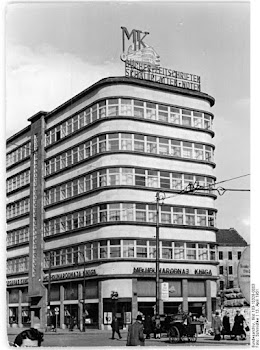Not being able to actually visit the Alexanderplatz of the 1930s, the next best thing is to watch a film clip. The one above, from the site www.history-vision.de, is from 1943, but Alexanderplatz was much the same then as in the 1930s. Click on the symbol at bottom right to switch to fullscreen.
The clip is a panning (panoramic) shot. The camera moves 180 degrees from right to left, starting from point 1 (see the blue digits in the map above). To begin with, we see the entrance to an U-Bahn and a bar and restaurant in the Engelhardt Haus (point 2 on the map), the former Grand Hotel Alexanderplatz.
Below left, Grand Hotel Alexanderplatz. Right: Engelhardt Haus (Source: Deutsche Brauindustrie in Wort und Bild
 |
The camera rotates slowly, we see a kiosk selling war-lottery, a tramway passes by and, after leaving behind us the Alexanderstrasse, we have in front of us Hertie (3), the large department store which was the principal aim of many of Alexanderplatz’ visitors. Its name had been Hermann Tietz, but the Nazis forced the Jewish owner to sell and the name was then changed to the less Jewish-sounding "Hertie".
The emblematic Berolina-statue stood here, on a 7-meter high pedestal (pic below left), but in 1927 it was taken away because of the U-Bahn work. In his famous novel with the same title as the square, Alfred Döblin conjectures that it had been carried away and melted to churn out medals; he was wrong but not that wrong, as we'll see soon. Berolina was replaced by an ultra modern construction with underground toilets and telephone booths (below right).But she appeared again in 1933, this time on the other side of Königstrasse, in front of the newly built Alexanderhaus, in front of Aschinger. But in the last years of the war, it was, as Döblin had foreseen, melted to make, not medals but bullets.
Next, over a planted traffic island, appears the south-easternmost part of the Berolinahaus (4), on the other side of a street that we don’t see but whose name was Am Königsgraben. Soon we see the semi-circular glass roof of the train station (Alexanderplatz Bahnhof) (5), behind Berolinahaus and the train viaduct over Königstrasse. Past the extremely busy Königstrasse, with its many different lines of tramway and with all the people coming from or going to the station, appears Alexanderhaus (6), with a look very similar to Berolinahaus, as they were designed by the same architect, Peter Behrens. The next short take shows the tram 65 heading westwards and behind it the Alexanderhaus again with the Jonass & Co sign in the second floor and the Aschinger restaurant and beer-hall.
Aschinger was a chain of restaurants and pubs all over Berlin. The Alexanderplatz branch, which appears in the TV-series Babylon Berlin, moved at least once as a consequence of the works to build new underground lines and to reorganize the traffic on the square. As for Jonass & Co, it was a store which shold on a credit basis.
 |
| Aschinger's first premises on Alex |
Had the camera continued shifting to the left, that is, to the north-east, it would have offered us a view of the St Georgen Church (7) with the Minolhaus (8) to the right. And, had this been not 1943 but 1927, we would have had the chance to admire, before the church, the magnificent building called "99 Schafsköpchen" (9), at the corner of Landsbergerstrasse and Neue Königsstrasse. Then we would have seen again the Engelhardt Haus and thus completed a full circle. We would then have covered the totality of the legendary Alexanderplatz, at least from a distance.
In the pic above, from 1936, we see the church and the Minolhaus to its left. In the large empty lot at the angle, stood until 1927 once the Haus mit den 99 Schafsköpfen (House with the 99 sheep's heads). In the foreground we see both modern Behrens' buildings and on the other side of the square, on the pics' left side, the Engelhardt Haus (Engelhard was a known brewer).
| The Haus mit 99 Schafsköpfen, built in 1783 |
 |
| Minolhaus (1951). |
The Minolhaus was an office and commercial building from the late 1920s, in the style known as New Objectivity. Its last user was the East German oil distributor Minol. It was torn down in 1968.
Let's recapitulate: the pic below shows the part of Alexanderplatz we saw in the movie: it is a view from the north.
And below, what we would have seen if the camera had been aiming at the opposite side. The other side of Alexanderplatz if you prefer. The pic is from around 1900, but we do see the church, behind the later disappeared House with 99 Sheep's Heads and to the left the Grand Hotel Alexanderplatz, which later became the Engelhardt Haus.
 |
| 1900 |
Below, the same but at the time of the clip we just watched: not the Hotel but the Engelhardt House and not the "Sheep house" but an empty lot.
 |
| 1936 |
 |






No comments:
Post a Comment